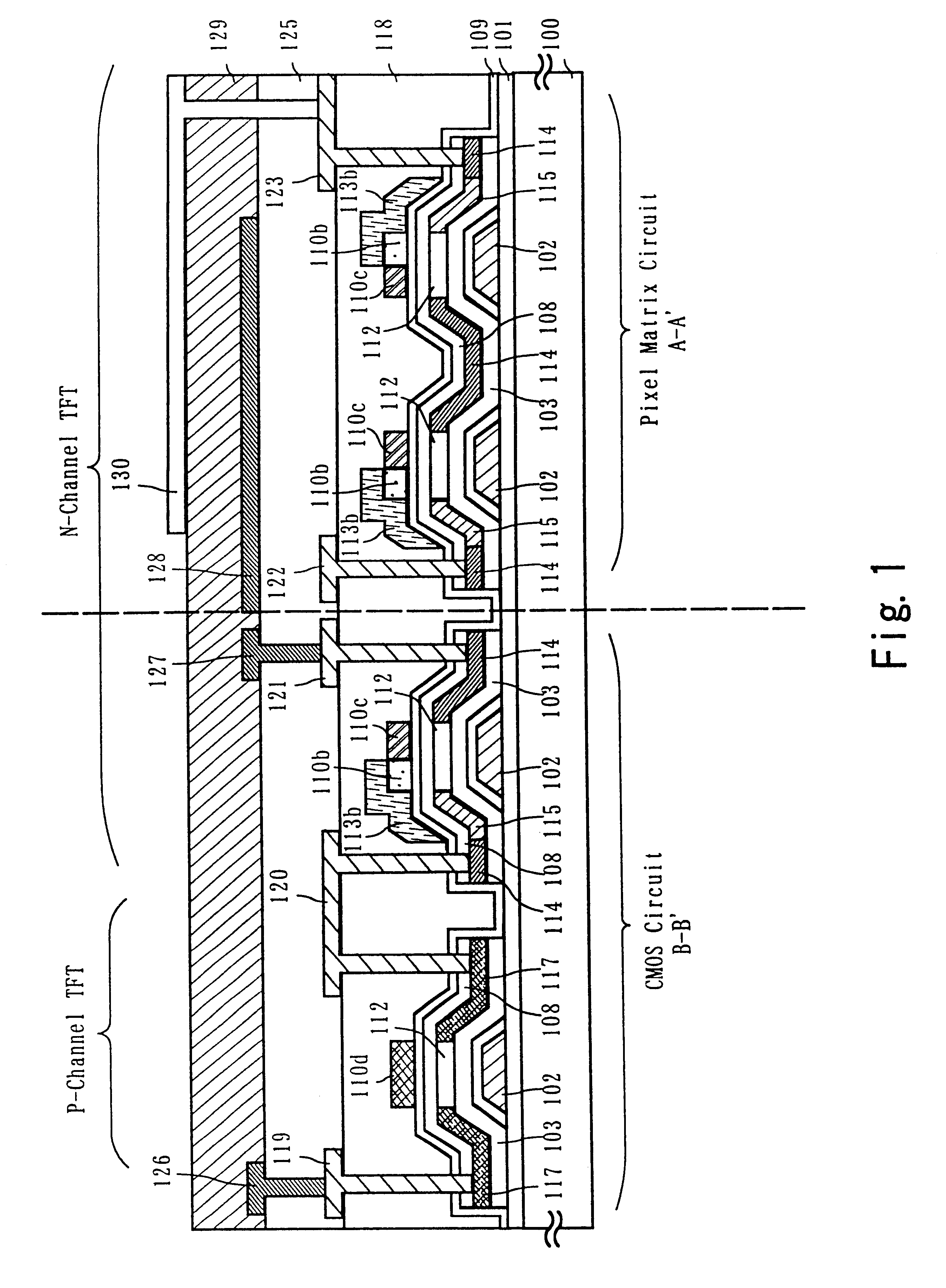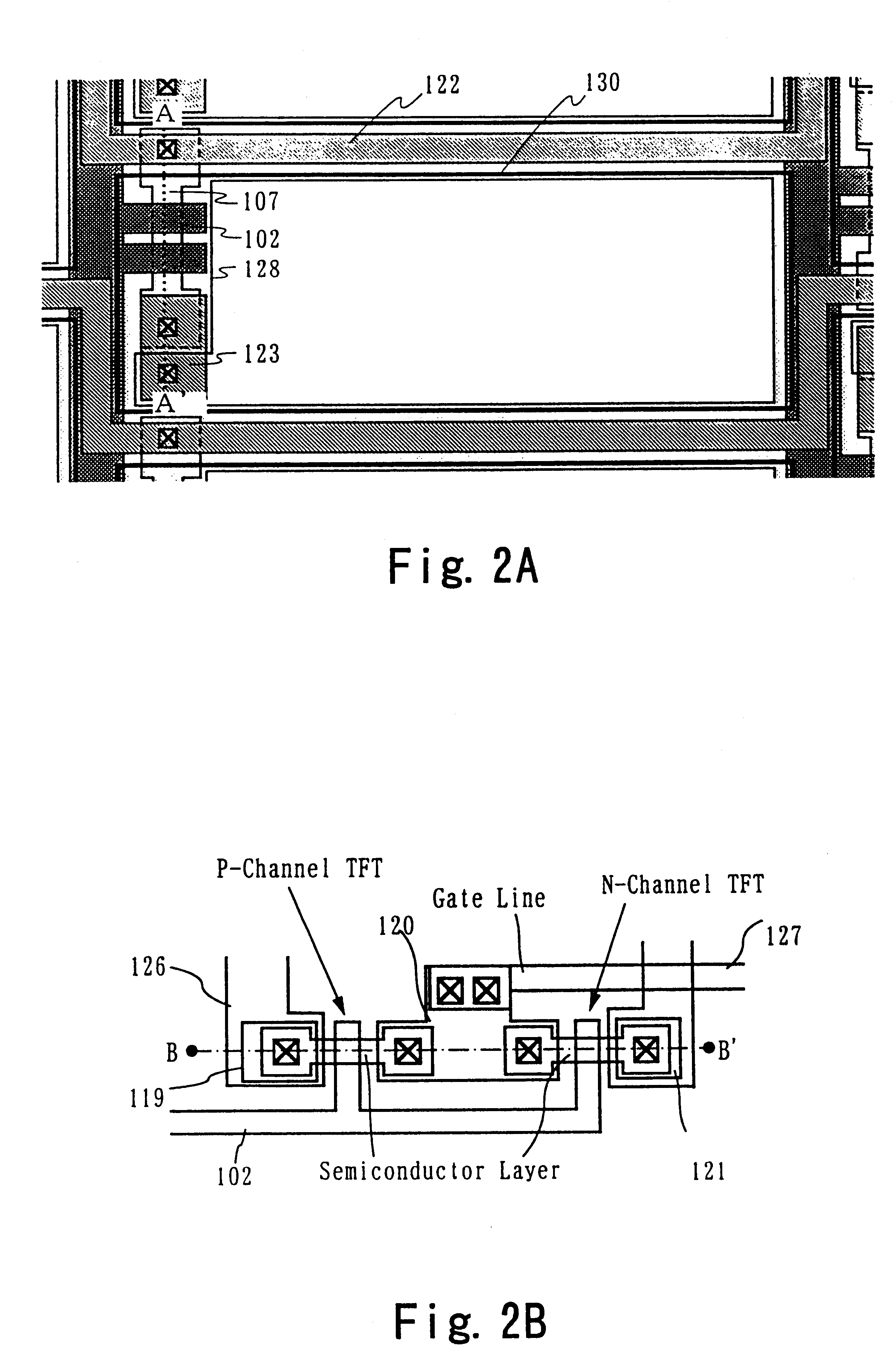Thin-film transistor with lightly-doped drain
a thin film transistor and drain technology, applied in the direction of static indicating devices, identification means, instruments, etc., can solve the problems of significant deterioration phenomena, difficult to provide elements having sufficient performance, and more severe requirements on the operation performance (especially, operating speed) of tfts
- Summary
- Abstract
- Description
- Claims
- Application Information
AI Technical Summary
Problems solved by technology
Method used
Image
Examples
first embodiment
A first embodiment will now be described. A typical embodiment of the present invention will now be described with reference to FIGS. 1 through 4. The present embodiment will be described with reference to a CMOS circuit that forms a part of a peripheral driving circuit portion and a pixel TFT that forms a part of a pixel matrix circuit portion provided on the same substrate. A description will be made with reference to FIGS. 3 and 4 on a method for manufacturing a semiconductor device including a semiconductor circuit formed by semiconductor elements according to the invention.
A substrate 100 is first prepared. The substrate 100 may be a glass substrate, a quartz substrate, an insulating substrate such as crystalline glass, a ceramic substrate, a stainless steel substrate, a metal (tantalum, tungsten, molybdenum or the like) substrate, a semiconductor substrate, a plastic substrate (polyethylene terephtalate substrate) or the like. In the present embodiment, a glass substrate (Coni...
second embodiment
A second embodiment will now be described. The present embodiment is an example in which a crystalline semiconductor film is obtained using a method different from that in the first embodiment. In the present embodiment, a step is added between the steps shown in FIGS. 3B and 3C of the first embodiment to cause a catalytic element for promoting crystallization to be carried on the entire surface of the semiconductor film or to be selectively carried. Since the present embodiment is substantially the same as the first embodiment in the basic configuration, the following description will address only differences between them.
The present embodiment is identical to the first embodiment up to the step of forming the semiconductor film 104 (FIG. 3B).
According to the present embodiment, a catalytic element for promoting the crystallization of silicon is introduced on the surface of the semiconductor film 104. As the catalytic element for promoting the crystallization of silicon, one or a p...
third embodiment
the invention will now be described. The present invention is an example in which a crystalline semiconductor film is obtained using a method different from that for the first embodiment. In the present embodiment relates to a method wherein laser beams are shaped into a rectangular or square configuration to perform a uniform laser crystallization process throughout an area in the range from several cm.sup.2 to several hundred cm.sup.2 with irradiation at one time, thereby providing a crystalline silicon film. Since this embodiment is substantially the same as the first embodiment in its basic configuration, the description will address only differences between them.
According to the present embodiment, irradiation is conducted with excimer laser light which is processed into a planar configuration at the step shown in FIG. 3C. The laser light must be processed into a planar configuration such that an area on the order of several tens cm.sup.2 (preferably 10 cm.sup.2) or more can be...
PUM
 Login to View More
Login to View More Abstract
Description
Claims
Application Information
 Login to View More
Login to View More - R&D
- Intellectual Property
- Life Sciences
- Materials
- Tech Scout
- Unparalleled Data Quality
- Higher Quality Content
- 60% Fewer Hallucinations
Browse by: Latest US Patents, China's latest patents, Technical Efficacy Thesaurus, Application Domain, Technology Topic, Popular Technical Reports.
© 2025 PatSnap. All rights reserved.Legal|Privacy policy|Modern Slavery Act Transparency Statement|Sitemap|About US| Contact US: help@patsnap.com



